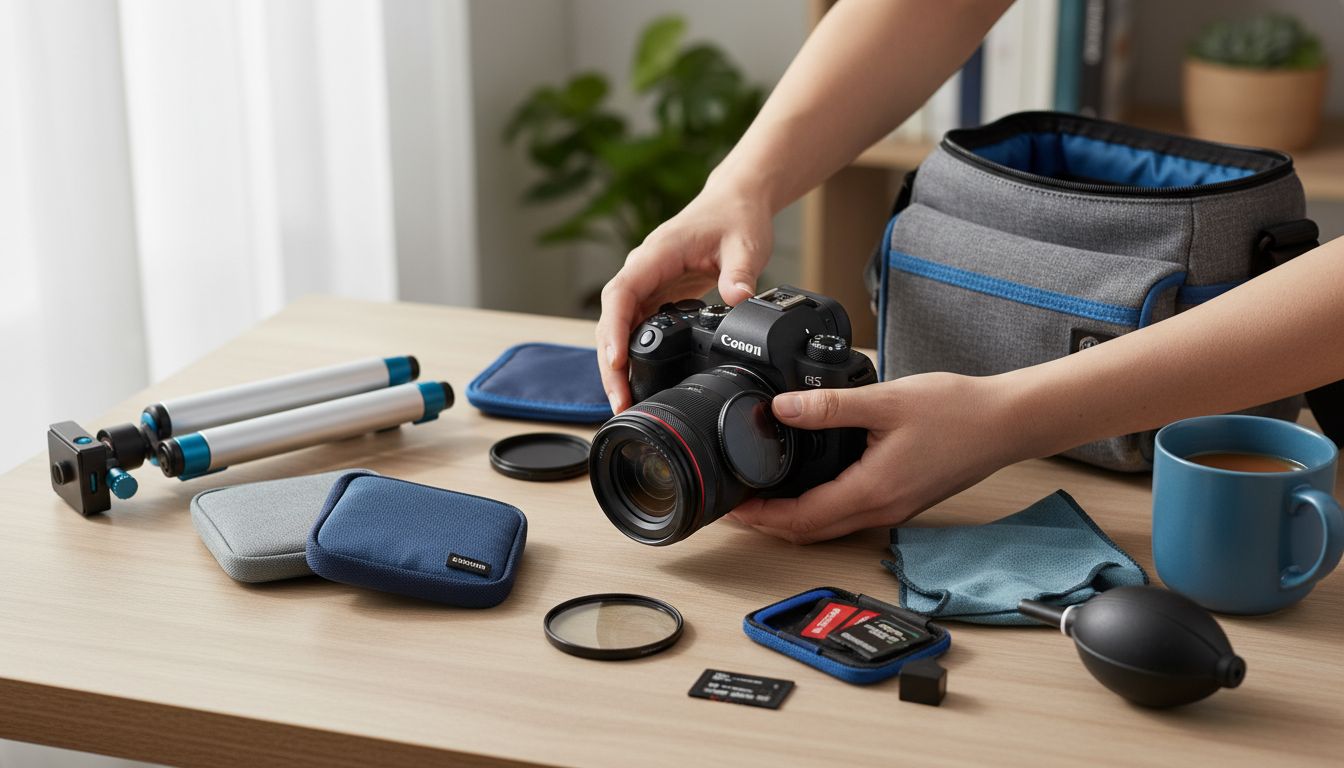Table of Contents
- Table of Contents
- Amateur Photographer Guide
- Digital Photography School
- <a href="https://shotkit.com" rel="nofollow">https://shotkit.com</a>
- Expert Photography
- Photography Life
- thephoblographer
- Improve Photography
- Camera Jabber
- Photography Resource Comparison
- Enhance Your Beginner Photography Kit with Expert Guidance
- Frequently Asked Questions
- Recommended
This blog post may contain affiliate links. As an Amazon Associate I earn from qualifying purchases.
Finding the right guide for your photography journey can be the difference between feeling stuck and getting real results with your camera. With so many choices out there, each offering its own approach to reviews, tutorials, and advice, it can be tough to know which path to follow. Some sites focus on learning new skills while others highlight the latest gear or inspire with real stories from working photographers. Curious what makes one platform stand out and how they help you become a better photographer? Discover how these resources measure up and what you might gain from each as you grow and experiment with your next photo project.
Table of Contents
- Amateur Photographer Guide
- Digital Photography School
- https://shotkit.com
- Expert Photography
- Photography Life
- thephoblographer
- Improve Photography
- Camera Jabber
Amateur Photographer Guide
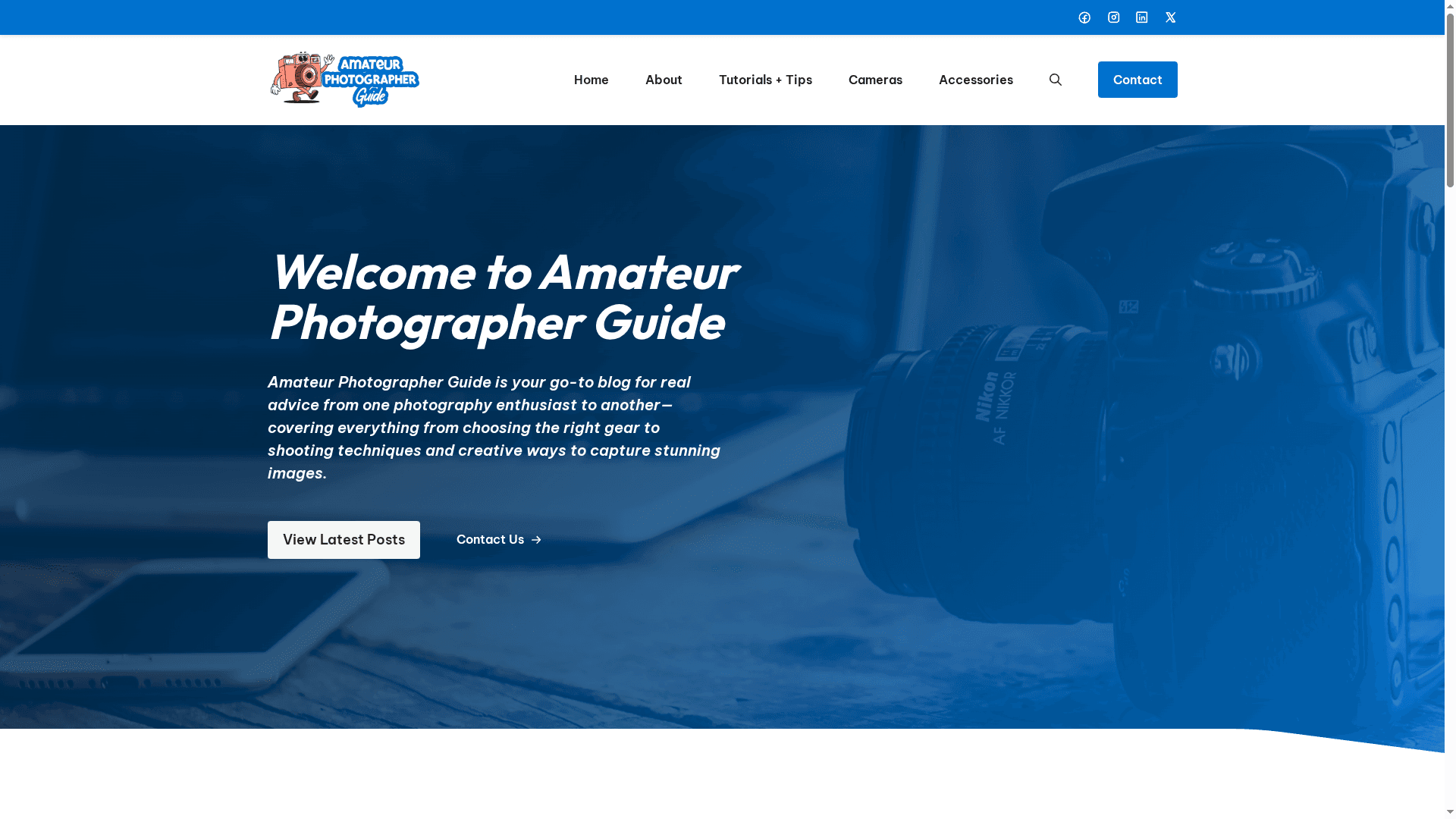
At a Glance
Amateur Photographer Guide is a focused, practical blog built for hobbyists and beginner photographers who want clear guidance without the noise. It delivers camera reviews, shooting techniques, editing advice, and gear checklists in a way that helps you make informed decisions and actually improve the pictures you take. If you want trustworthy, usable content that respects budgets and learning curves, this site is designed with you in mind.
Core Features
The site combines five core offerings that map directly to a beginner’s needs: camera reviews that compare real-world options, step-by-step shooting techniques and tips, editing advice and recommended tools, gear packing checklists to simplify outings, and regular updates on trends in photography equipment. These features are organized into categories so you can quickly find basics, intermediate lessons, or gear-focused guides depending on where you are in your learning journey.
Pros
- Comprehensive coverage of amateur photography topics: The blog spans gear, technique, and creativity so you don’t have to chase multiple sites for basic answers.
- Practical advice from experienced photographers: Articles focus on usable tips you can apply on shoots rather than abstract theory.
- Categorized content for easy navigation: Clear sections and checklists make it fast to find exactly what you need before a shoot.
- Focus on both technical and creative aspects: You’ll get exposure settings and composition ideas—both matter for better images.
- Accessible for all skill levels and budgets: Content respects budget constraints and teaches fundamentals that scale as you grow.
Who It’s For
This site is ideal for amateur photography enthusiasts at any stage who want reliable, actionable guidance. If you’re choosing your first DSLR or mirrorless camera, trying to learn composition, or searching for gear lists before a weekend shoot, Amateur Photographer Guide speaks your language. It’s especially useful for self-taught photographers who prefer clear articles and checklists over long-form academic lessons.
Unique Value Proposition
Amateur Photographer Guide stands out because it’s built as an educational hub rather than a storefront. The site prioritizes usability: categorized articles, practical checklists, and concise reviews are all aimed at enabling confident decisions. Where many competitor sites mix reviews with heavy sales pitches, this guide emphasizes learning—combining technical how-tos with creative prompts so beginners progress faster. It also balances breadth and accessibility: covering trends and gear while keeping explanations simple enough for newcomers and useful enough for enthusiasts. In short, you get a streamlined learning path from camera choice to shooting and editing, backed by checklists and expert insight that reduce overwhelm and accelerate real improvement.
Real World Use Case
A hobbyist uses the blog to choose their first DSLR, following a review-based comparison to narrow options, reading composition tips to improve framing, and using a packing checklist before their first outdoor shoot—resulting in more confident shooting and better final images.
Pricing
Free access to all blog content
Website: https://amateurphotographerguide.com
Digital Photography School
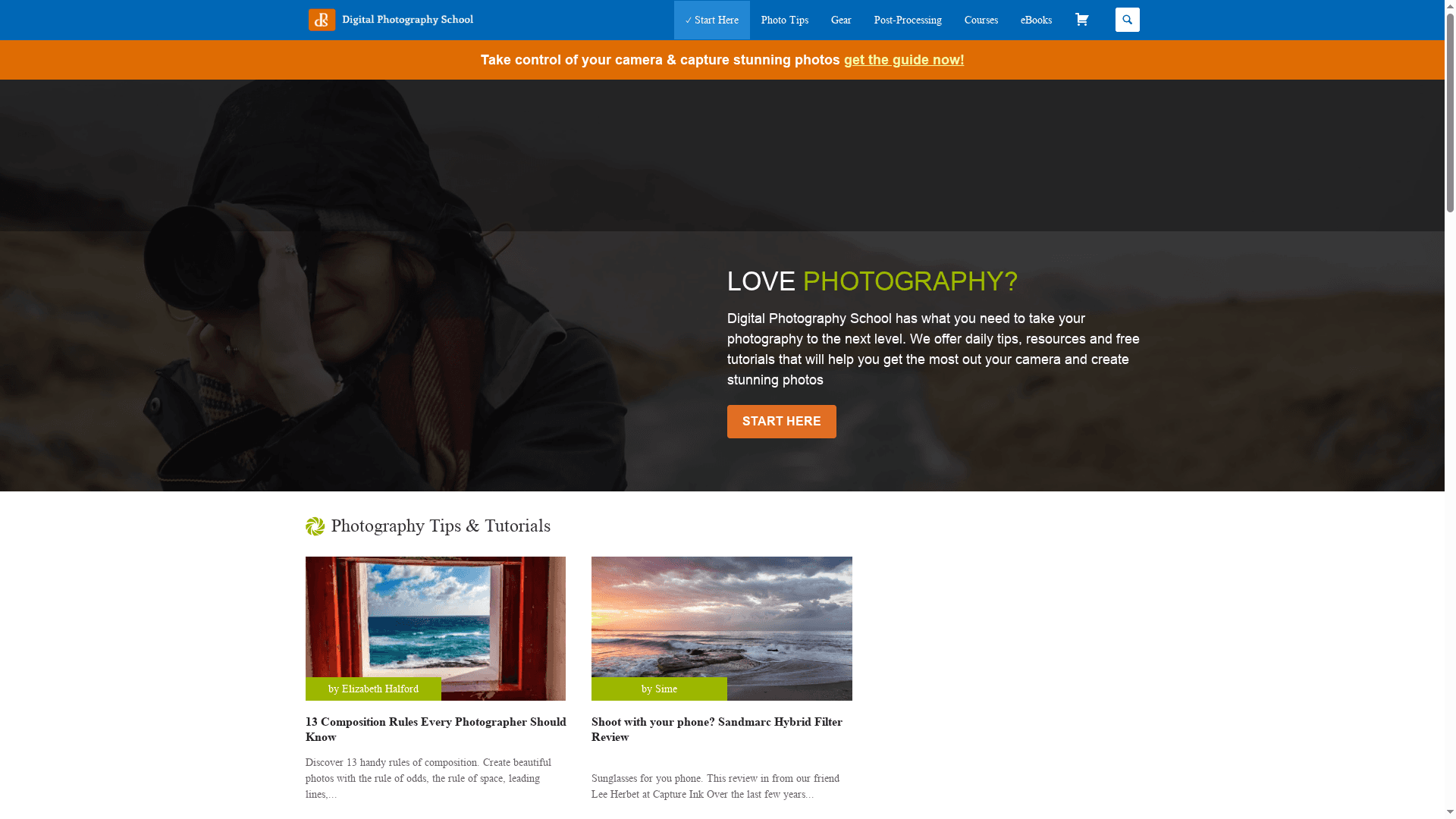
At a Glance
Digital Photography School is a practical, no-nonsense resource for photographers who want steady, measurable improvement. It delivers daily tips, step-by-step tutorials, and gear guidance that beginners can act on immediately, while also offering deeper articles for intermediate users. The emphasis on both creative technique and business basics makes it especially useful for hobbyists looking to turn a side passion into income. Expect mostly written lessons and free content, with occasional paid guides for advanced topics.
Core Features
Digital Photography School focuses on regular, accessible education: daily photography tips and tutorials, comprehensive guides on composition and editing, hands-on gear reviews, and practical business advice including pricing strategies. The site also serves smartphone photographers with specialized tips and retains content that scales up to advanced camera users. In short, it’s a broad curriculum built around written how-tos, illustrated examples, and curated equipment recommendations rather than video-first instruction.
Pros
- Covers a wide range of topics suitable for all experience levels: The site structures content so beginners can learn fundamentals while intermediate photographers find deeper technique and editing guidance.
- Free tutorials and resources accessible online: Many articles and how-tos are available at no charge, letting you start improving immediately without financial commitment.
- Practical advice from experienced photographers and editors: Lessons emphasize actionable steps—composition rules, camera control tips, and post-processing workflows—so you can reproduce results quickly.
- Helpful guides on creative and technical aspects of photography: The site balances artistic composition advice with technical explanations, helping you connect vision to execution.
- Includes business tips to monetize photography: Beyond shooting and editing, there are clear articles on pricing strategies and running a photography business, useful if you plan to sell your work.
Cons
- Content is mostly written articles and may lack extensive video tutorials: If you learn best by watching and following along, the text-first approach can feel limiting compared with video courses.
- Some tutorials may require a subscription or purchase for advanced content: While a lot is free, certain in-depth guides and resources sit behind paywalls or premium offerings.
- Focuses mainly on technical and creative aspects rather than community or networking features: The site is education-focused and doesn’t prioritize community-building tools like integrated forums or networking platforms.
Who It’s For
Digital Photography School is ideal for hobbyists, beginners, and self-taught photographers who want structured, practical lessons they can apply immediately. It’s also valuable for intermediate shooters looking to refine editing workflows or learn business basics. If you prefer reading clear examples and acting on concise how-tos, this site will fit your learning style.
Unique Value Proposition
The site’s strength is consistent, applied guidance: daily tips plus deep-dive written tutorials that connect creative composition, camera control, and post-processing with real-world gear advice and pricing strategies. It’s a one-stop written resource that helps photographers improve both craft and career focus.
Real World Use Case
A hobbyist uses a series of composition tutorials to improve portrait framing, follows a post-processing guide to standardize editing in Lightroom, and later consults pricing articles when deciding to accept paid commissions—moving from casual shooting to paid assignments.
Pricing
Free tier available; some premium guides and resources require purchase or subscription.
Website: https://digital-photography-school.com
https://shotkit.com
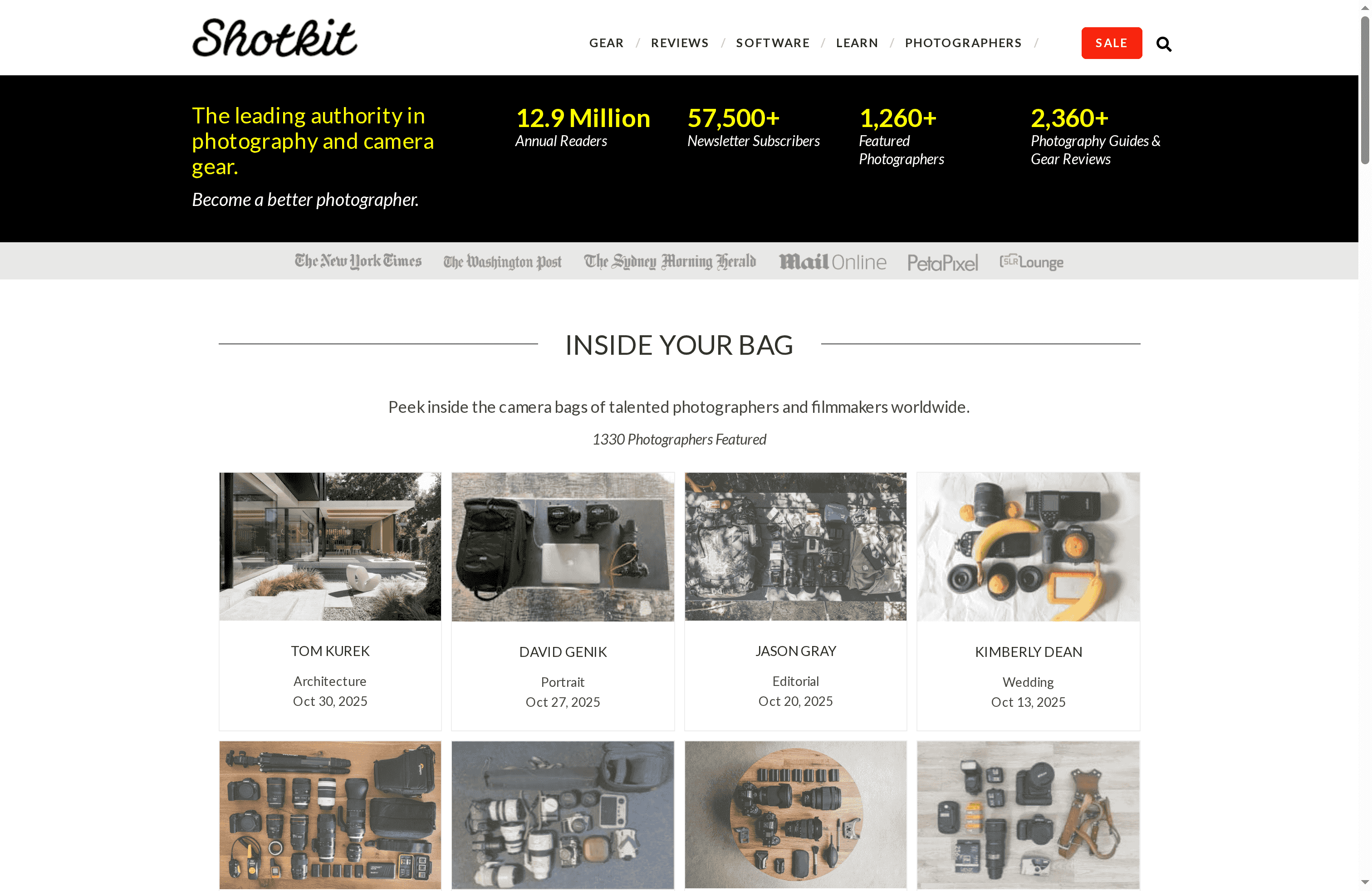
At a Glance
Shotkit is an inspirational photography site that combines gear guides, camera-bag reveals from professionals, and practical business advice aimed at photographers at any stage. The site excels at helping you decide what kit to consider and how other shooters actually use it in the field. If you want well-organized gear information and pricing guidance, Shotkit delivers consistently. However, absolute beginners may find the depth and gear focus a little overwhelming at first.
Core Features
Shotkit’s core strengths are its extensive photography guides and gear reviews, insider camera-bag breakdowns from working professionals, and a steady stream of educational tips and tutorials. The site covers a wide range of kit — lenses, microphones, tripods, and related accessories — while also offering gear comparisons and practical pricing guidance for prints and photography services. Content is clearly aimed to inform both buying decisions and business choices, making it a centralized resource for technical and commercial aspects of photography.
Pros
- Extensive guide library: Shotkit hosts a large collection of photography guides and gear reviews that make researching equipment faster and more focused.
- Real-world insights from pros: The camera-bag features give concrete, practical examples of how established photographers assemble and use their kit in actual shoots.
- Business-minded advice: It provides actionable, practical advice on pricing and selling photos, helping photographers think beyond the camera.
- Beginner-friendly navigation: The site is user-friendly and deliberately structured to help both amateurs and pros find useful, actionable content quickly.
- Regularly refreshed material: Content is updated frequently, so the guides and reviews reflect the latest trends and technologies in photography.
Cons
- Heavy gear emphasis: The site is mostly focused on gear and technical guides, which means artistic and creative process content is less prominent.
- Can overwhelm absolute beginners: Because of its depth and variety, newcomers may feel unsure where to start or which article best matches their immediate learning needs.
- High-level pricing guidance: Pricing guides are useful but remain high-level, and you may need additional, specific research to set rates in your local market.
Who It’s For
Shotkit is ideal for photographers who want to make smarter gear choices, see how professionals kit up, and start building the business side of their craft. That includes curious beginners ready to learn about equipment, hobbyists upgrading their kit, and working photographers who want to refine pricing and workflow strategies.
Unique Value Proposition
Shotkit’s unique value lies in combining detailed gear reviews with real camera-bag breakdowns and business-focused advice — all in one place. Rather than a single-angle review site, it shows you gear in action and pairs that with practical tips to help you use and monetize your photography.
Real World Use Case
A professional photographer consults Shotkit to compare lenses for a portrait series, then reviews camera-bag profiles to optimize kit for a travel shoot, and finally reads pricing guides to set print rates for an upcoming gallery showing.
Pricing
Free to access
Website: https://shotkit.com
Expert Photography
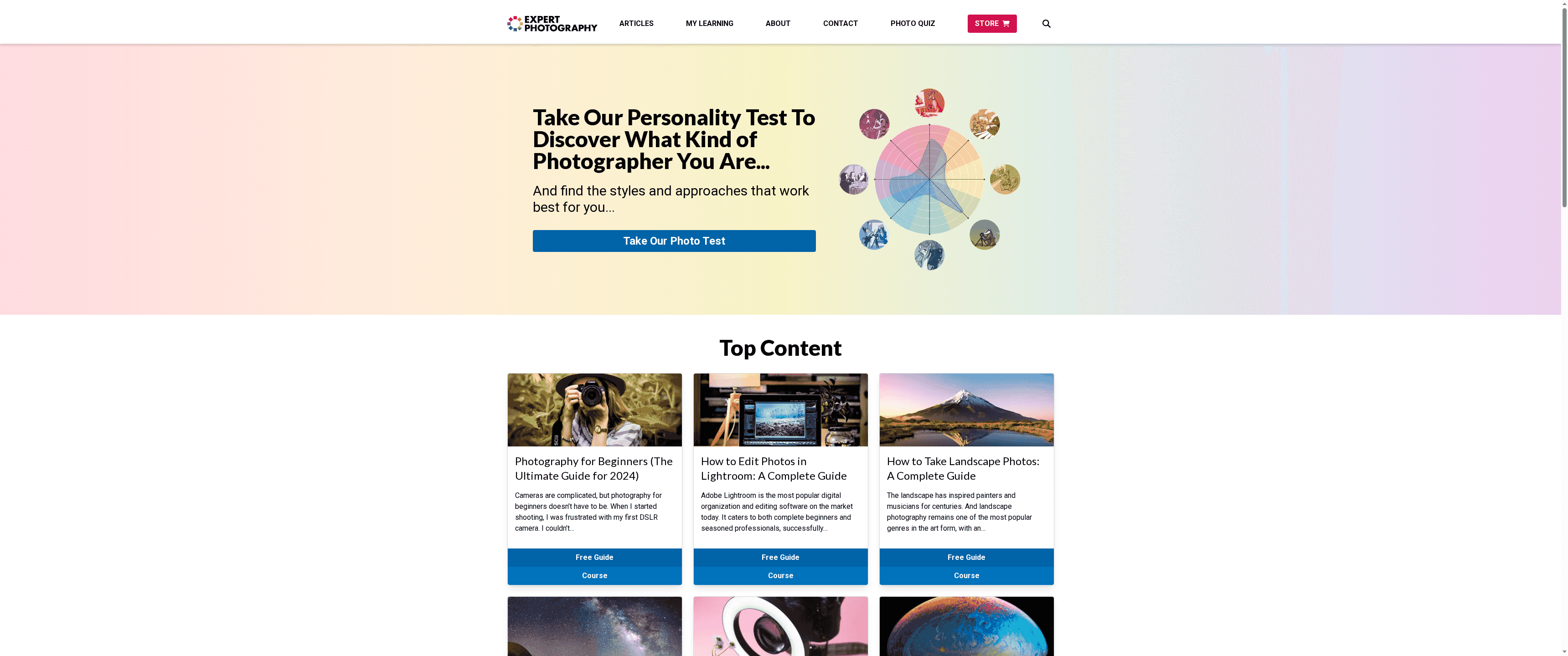
At a Glance
Expert Photography is a comprehensive learning hub that serves photographers from beginner to advanced levels with free guides, how-to articles, and focused courses. Its strengths are breadth and accessibility—there’s practical guidance on camera settings, genres, and editing workflows. If you want a content-first resource to learn techniques and compare tools like Lightroom vs. Capture One, this site delivers. Expect minimal commercial push and a heavy emphasis on educational material.
Core Features
Expert Photography centers on educational content: free photography guides and courses, in-depth articles about techniques and genres, comparisons of photo-editing software, and practical guides to camera gear and lens types. The site also publishes recent articles on equipment and influential photographers, which helps you stay current with trends and real-world examples. The mix of beginner guides and advanced editing tutorials (including Lightroom and Photoshop coverage) makes it a versatile learning resource.
Pros
- Wide range of educational content: The site covers everything from basic camera settings to advanced editing, which makes it useful as a single learning reference.
- Free guides and tutorials are widely available: Many resources can be accessed at no cost, lowering the barrier for hobbyists and newcomers.
- Timely articles on trends and gear: Regularly updated content helps you keep pace with new techniques and commonly discussed equipment.
- Useful for multiple skill levels: Both beginners and more experienced shooters can find actionable lessons and comparisons.
- Includes software comparisons and reviews: Objective discussions about tools like Lightroom and Capture One aid decision-making.
Cons
- Primarily educational, not a product storefront: The site focuses on learning and does not function as a direct marketplace for buying physical gear.
- Limited transparency on paid options: There is little clear information about paid courses or subscriptions, which can leave users unsure about premium offerings.
- Design and navigation are basic: The site’s layout may feel plain to users who prefer a more modern, visually-driven interface.
Who It’s For
Expert Photography is ideal for hobbyists, self-taught shooters, and intermediate photographers who want structured learning without big upfront costs. If you value clear tutorials, software comparisons, and genre-specific guidance over shopping or product-heavy reviews, this site fits your needs well.
Unique Value Proposition
The site’s unique value lies in its educational-first approach: a large library of free, practical content that connects technique, gear basics, and software workflows. That combination makes it a go-to resource for learning and skill improvement rather than product purchasing.
Real World Use Case
A hobbyist uses Expert Photography to learn composition basics, follows a step-by-step Lightroom workflow article to edit landscape shots, and checks software comparison pieces before trying a 30-day trial of a new editor. The site keeps that photographer informed without a hard sell.
Pricing
Starting at free (most content appears to be free; no specific pricing information available for premium features or courses).
Website: https://expertphotography.com
Photography Life

At a Glance
Photography Life is a comprehensive online resource that delivers news, reviews, tutorials, and practical guides for photographers at every level. Its strength lies in timely camera and lens reviews coupled with hands-on tutorials that emphasize nature and wildlife photography. If you want clear, gear-focused guidance and actionable shooting tips, Photography Life delivers consistently. Expect primarily English-language content and a strong emphasis on gear and technique.
Core Features
Photography Life aggregates photography news updates, in-depth camera and lens reviews, step-by-step articles and tutorials on photographic techniques, and practical guides for fieldwork. It also offers targeted tips for wildlife and nature photography and publishes contributions from respected authors in the community. The site’s combination of review-driven content and technique-focused articles makes it easy to move from learning a concept to assessing a piece of gear that helps you apply it.
Pros
- Extensive and up-to-date photography content: The site regularly publishes news and reviews, keeping readers informed about the latest gear and developments.
- Suitable for photographers of all levels: Content ranges from beginner-friendly tutorials to advanced technique guides, making it useful across skill levels.
- Provides practical tips and detailed reviews: Articles are oriented toward actionable advice and hands-on evaluation rather than abstract theory.
- Focus on nature and wildlife photography: Readers interested in wildlife receive specialized tips and reviews tailored to telephoto lenses and field shooting.
- Well-respected author contributions: Expert authorship lends credibility and depth to reviews and tutorials.
Cons
- Content may be predominantly in English: Non-English speakers may find limited localization or translated content.
- Focused mainly on camera gear and techniques, possibly limiting broader photography topics: Readers seeking deep coverage of non-gear topics—like business of photography, multimedia workflows, or cultural history—may find the scope narrower than expected.
Who It’s For
Photography Life is best for hobbyists, beginner and intermediate photographers, and nature enthusiasts who prioritize gear research and technique improvement. If you spend time choosing the right lenses or want concrete advice for bird and wildlife shooting, this site will fit your needs. It’s less ideal if you’re searching for broad lifestyle or business-of-photography content.
Unique Value Proposition
Photography Life stands out by pairing authoritative, gear-centric reviews with practical, technique-oriented tutorials—especially for nature and wildlife shooters. That blend helps readers make informed buying decisions and immediately apply new methods in the field, shortening the learning curve between research and results.
Real World Use Case
A wildlife photographer reads Photography Life to compare the latest telephoto lenses, then studies a step-by-step tutorial on bird-in-flight techniques to apply during the next dawn outing. The result: smarter equipment choices and technique refinements that improve keeper rates in the field.
Pricing
Free tier available; the site is free to access with potential paid content or subscriptions for premium features.
Website: https://photographylife.com
thephoblographer

At a Glance
The Phoblographer is a focused photography site that combines timely news, camera and accessory reviews, and thoughtful pieces on photography culture. It’s a solid destination if you want regular updates on product launches and industry developments, with the option to remove ads via a low-cost subscription. The site leans more toward news and critique than step-by-step tutorials, so it’s best used as a review and trends resource rather than an instructional hub.
Core Features
The Phoblographer publishes the latest news and reviews on cameras, lenses, and photography accessories alongside longer opinion and culture pieces. It tracks industry updates such as new product launches and firmware changes, encourages community engagement through comments, and offers a paid ad-free subscription that unlocks exclusive content and a cleaner reading experience. Regular updates aim to keep readers current on products and trends.
Pros
- Comprehensive product coverage: The site delivers thorough news and reviews across cameras, lenses, and accessories, which helps you compare options quickly.
- Frequent updates: Regular posts on new products and firmware mean you won’t miss important announcements or timely review perspectives.
- Ad-free subscription available: For $3.99 per month, subscribers get an uncluttered reading experience and access to exclusive content, improving focus and convenience.
- Depth for different experience levels: The mix of straightforward reviews and deeper culture-focused pieces makes the site useful to both beginners and professionals looking for context.
- Industry-focused commentary: Coverage of photography culture and industry shifts provides perspective beyond spec sheets, helping you understand why a release matters.
Cons
- Some missing or broken pages: A few pages may be unavailable or lack content, which can interrupt research and lead to frustration when you’re trying to find specific information.
- Limited tutorial content: The site emphasizes news and reviews over hands-on tutorials, so beginners seeking guided how-tos or structured learning may need to look elsewhere for step-by-step instruction.
- Subscription required for ad-free access: While reasonably priced, the $3.99 monthly fee may be a hurdle for casual readers who dislike paywalls or ads.
Who It’s For
The Phoblographer is ideal for amateur and professional photographers, gear-focused enthusiasts, and anyone researching camera and lens purchases who wants timely reviews and industry context. If you prefer reading critical evaluations and cultural commentary to structured lesson plans, this site fits your workflow.
Unique Value Proposition
The Phoblographer stands out by blending frequent, gear-centric news and reviews with essays about photography culture—an approach that helps readers not only pick equipment but also understand its place in the broader photographic landscape. The ad-free subscription offers a low-cost way to get exclusive content and a distraction-free browsing experience.
Real World Use Case
A photographer researching a mirrorless body consults The Phoblographer to read hands-on reviews, check recent firmware notes, and absorb opinion pieces that compare real-world usability rather than just specs. They use that context to shortlist models and decide whether to test them in person.
Pricing
Starting at $3.99 per month for the ad-free experience and exclusive content.
Website: https://thephoblographer.com
Improve Photography
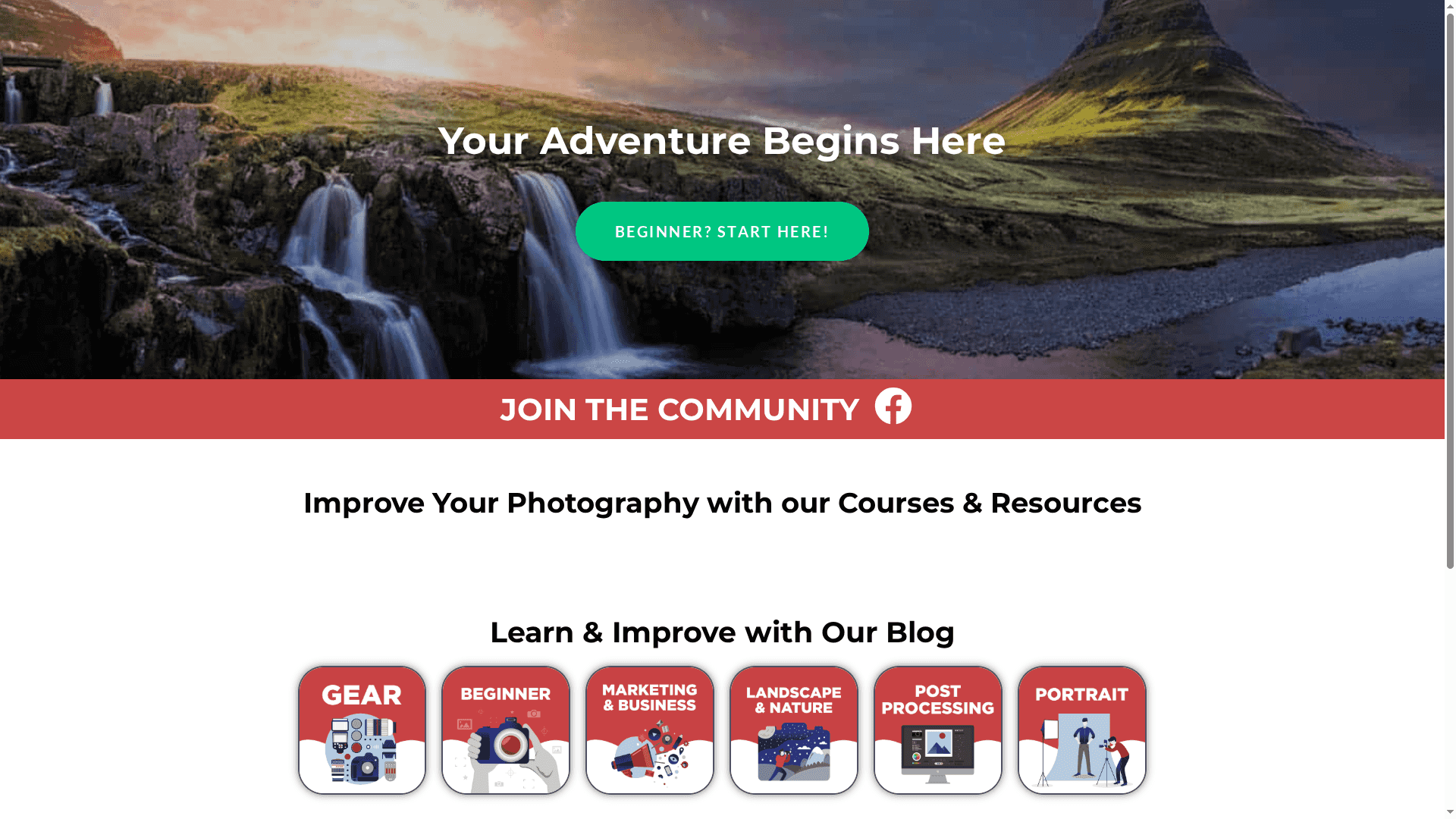
At a Glance
Improve Photography is a resource-rich platform that helps photographers level up through courses, articles, podcasts, and an engaged community. It’s especially strong for those interested in fine art and nature photography, with practical guidance on both technique and how to price and sell prints. If you want a single hub for learning and business-minded advice, this site is a solid starting point. Expect a mix of free and paid material, so plan on evaluating which parts you’ll need most.
Core Features
The site combines several learning formats: photographic courses and tutorials for structured skill-building, a blog with articles and practical tips, and podcast episodes that dive into photographic topics and business strategy. Community engagement and shared resources create opportunities to get feedback and stay motivated, while specific guides on pricing and selling photography prints bridge the gap between creative work and earning income. Together these elements create a learning ecosystem rather than a single product.
Pros
- Comprehensive learning resources for photographers: The platform gathers courses, tutorials, articles, and podcasts so you can learn in the format that suits you best.
- Community-oriented towards photographers of all levels: Community features make it easier to get feedback, ask questions, and stay accountable as you learn.
- Specialized content on fine art and nature photography: If you shoot landscapes or nature subjects, the site’s niche guidance on fine art and printing is directly relevant and practical.
- Accessible online platform with diverse content types: The mix of written guides and audio episodes means you can learn at your desk or on the go.
Cons
- Some content may be more focused on specific photography niches: The emphasis on fine art and nature photography means other genres may receive less coverage.
- Mix of free and paid content which may require subscription for full access: To reach the deeper courses and structured pathways you’ll likely encounter paywalls or subscription prompts.
- Limited information on specific product or service offerings from the site itself: The site positions itself as a resource hub rather than a storefront, so details about bundled services or clear pricing plans are not prominent.
Who It’s For
Improve Photography is aimed at photographers of all levels but delivers the most value to beginners and intermediate shooters who want guided learning plus practical advice on monetizing work. If you’re building technical chops and also thinking about how to price and sell prints—especially nature or fine art photography—this platform is designed with your needs in mind.
Unique Value Proposition
What sets Improve Photography apart is its combination of creative instruction and business guidance in one place. It doesn’t just teach camera settings; it helps you translate images into a priced product and provides community input along the way. That blended approach is useful for hobbyists aiming to become sellers.
Real World Use Case
A nature photographer preparing to sell limited-edition prints could use step-by-step tutorials to refine capture technique, follow pricing guides to set print values, and listen to podcast episodes about art sales to shape a marketing approach. Community feedback can then validate print presentation and pricing before launch.
Pricing
Pricing details are not specified; the site features courses and resources which may have associated costs.
Website: https://improvephotography.com
Camera Jabber

At a Glance
Camera Jabber is a focused photography resource that delivers timely news, hands-on reviews, and practical tutorials aimed at photographers who want to stay current with gear and technique. The site’s frequent updates and detailed analyses make it a dependable first stop when a new camera or lens hits the market. It’s not a catch-all photography magazine — it intentionally centers on equipment and industry developments, which is both its strength and its limitation.
Core Features
Camera Jabber aggregates the latest news on camera releases and photography gear, pairs that with in-depth reviews of cameras, lenses, and accessories, and supplements technical coverage with step-by-step tutorials and how-to guides. The site also tracks industry trends and innovations, giving readers context about where camera technology and accessories are headed. Together these features provide a clear, gear-centric editorial mix that helps readers compare specs, evaluate performance, and learn practical techniques to get the most from new equipment.
Pros
- Comprehensive coverage of photography news and reviews: The site consistently publishes updates and review pieces that span cameras, lenses, and accessories, making it easy to follow new releases in one place.
- Detailed and expert insights: Reviews and guides are written with technical depth, helping readers understand performance trade-offs rather than only presenting surface-level impressions.
- Covers a wide range of photography topics and gear: From gimbals to lighting and lenses, the editorial scope addresses many categories a photographer might research before buying.
- Updated frequently with latest information and trends: Regular content refreshes mean the site is useful for timely purchase decisions and for tracking evolving camera technology.
Cons
- The website may be limited to readers interested specifically in photography and camera gear: If you’re looking for broad creative or business-side photography content, Camera Jabber’s gear focus may feel narrow.
- Content is mostly focused on photography equipment and may not cover broader photography topics extensively: Topics like photographic style, long-form photo essays, or business guidance receive less attention compared with technical gear coverage.
Who It’s For
Camera Jabber is best for photography enthusiasts, amateur photographers, and professionals who prioritize gear knowledge — people who want objective spec comparisons, informed reviews, and actionable tutorials tied to the latest hardware. If you make purchase decisions based on specifications, sample images, and hands-on testing, this site matches your needs.
Unique Value Proposition
Camera Jabber’s value lies in its concentrated combination of breaking gear news and technical reviews paired with practical how-to content. That mix helps readers move quickly from discovery (what’s new) to evaluation (how it performs) to implementation (how to use it), all within a single resource.
Real World Use Case
A photographer planning to upgrade their camera body consults Camera Jabber to read side-by-side reviews, check sample images, and review tutorials on new features; those resources shorten research time and increase confidence in the final purchase decision.
Pricing
Free access to all content.
Website: https://camerajabber.com
Photography Resource Comparison
This table provides a comprehensive overview of various photography websites, highlighting their features, pros, cons, and pricing. It is designed to help photographers choose the right resource based on their needs.
| Resource | Features | Pros | Cons | Pricing |
|---|---|---|---|---|
| Amateur Photographer Guide | Camera reviews, shooting techniques, editing advice, gear checklists | Comprehensive coverage, practical advice, accessible for all skill levels | None noted | Free |
| Digital Photography School | Daily tips, tutorials, gear guidance, business advice | Wide range of topics, free resources, practical advice | May lack video tutorials, some content behind paywalls | Free, some paid guides |
| Shotkit | Photography guides, gear reviews, camera-bag breakdowns | Extensive guide library, real-world insights, business advice | Heavy gear emphasis, can overwhelm beginners | Free |
| Expert Photography | Free guides, how-to articles, courses | Wide educational content, timely articles, software comparisons | Not a product storefront, basic design | Mostly free |
| Photography Life | News, reviews, tutorials, nature photography focus | Extensive content, practical tips, suitable for all levels | English-focused, mainly gear and techniques | Free |
| The Phoblographer | News, reviews, cultural commentary | Comprehensive product coverage, frequent updates, ad-free option | Limited tutorials, subscription for ad-free access | $3.99/month for ad-free |
| Improve Photography | Courses, articles, podcasts, community engagement | Comprehensive learning, community-oriented, fine art and nature focus | Mixed free/paid content, niche focus | Mixed pricing |
| Camera Jabber | Photography news, reviews, tutorials | Comprehensive gear coverage, detailed insights, frequent updates | Gear-focused, limited broader photography topics | Free |
Enhance Your Beginner Photography Kit with Expert Guidance
Starting with the right accessories can feel overwhelming when you want to capture stunning images from day one. The “8 Best Photography Accessories for Beginners – Expert Comparison 2025” article highlights common challenges like choosing gear that fits your skill level and budget while avoiding unnecessary purchases. You likely want to build confidence behind the camera and find equipment that truly supports your creative vision without confusion.
At Amateur Photographer Guide, we understand the need for clear, practical advice that bridges the gap between beginner uncertainty and expert insight. Our blog offers detailed camera buying guides and easy-to-follow shooting tips designed to empower you with knowledge on both essential gear and effective techniques. Equipped with our expert checklists and friendly tutorials, you can confidently select the accessories you really need and improve your photography fast.
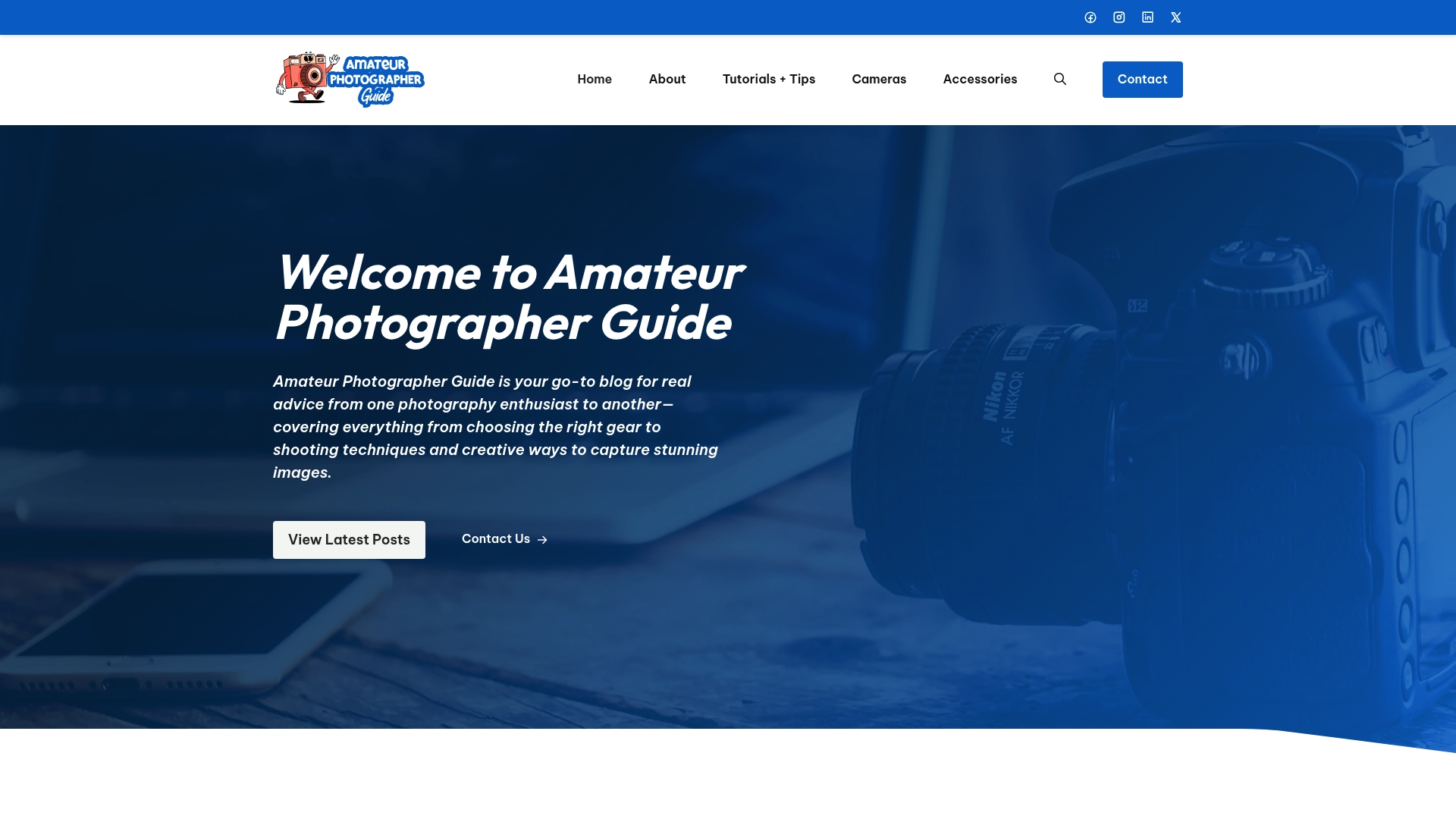
Ready to upgrade your photography experience? Visit Amateur Photographer Guide today to explore essential gear recommendations and beginner-focused guides that will help you make informed choices. Don’t wait to transform your shots and enjoy photography the way it was meant to be – simple and rewarding.
Frequently Asked Questions
What photography accessories should beginners invest in?
Invest in accessories that enhance your shooting experience, such as a sturdy tripod, lens filters, and a camera bag. These items help stabilize your shots, protect your gear, and simplify transport, improving your overall photography process.
How do I choose the right tripod for beginner photography?
To select an appropriate tripod, consider factors such as weight, height, and stability. Opt for a model that can support the weight of your camera equipment and is easy to carry; for example, look for a tripod that weighs under 5 pounds for portability.
What type of lens filters are recommended for beginners?
Beginner photographers should consider a UV filter for lens protection and a polarizing filter to reduce glare and enhance colors. Start by purchasing a UV filter for each lens you own, as this can improve image quality and extend the lifespan of your lenses.
How can I effectively use a camera bag to organize my photography gear?
A well-designed camera bag helps you organize gear by providing compartments for different accessories and lenses. Arrange your camera, lenses, and accessories systematically; for instance, place heavier items like your camera body at the bottom and lighter accessories above to maintain stability.
Why is a cleaning kit essential for beginner photographers?
A cleaning kit is crucial for maintaining your camera and lenses, as it removes dust and smudges that can affect image quality. Invest in a basic cleaning kit containing a lens cloth, blower, and cleaning solution, and clean your gear regularly to ensure optimal performance.
What should I look for in extra camera batteries for beginners?
When choosing extra camera batteries, focus on capacity, compatibility, and brand reliability. Select batteries with higher mAh ratings to extend shooting time; for example, consider batteries that offer at least 2000 mAh for a longer duration of use during shoots.
Recommended
- 8 Essential Camera Accessories Every Photographer Needs – Amateur Photographer Guide
- What Pro Photographers Won’t Tell You: A Honest Camera Equipment List for Beginners – Amateur Photographer Guide
- 7 Photography Gear Essentials Every Beginner Should Know – Amateur Photographer Guide
- Buying A Digital Camera: 7 Important Things To Look For – Amateur Photographer Guide

